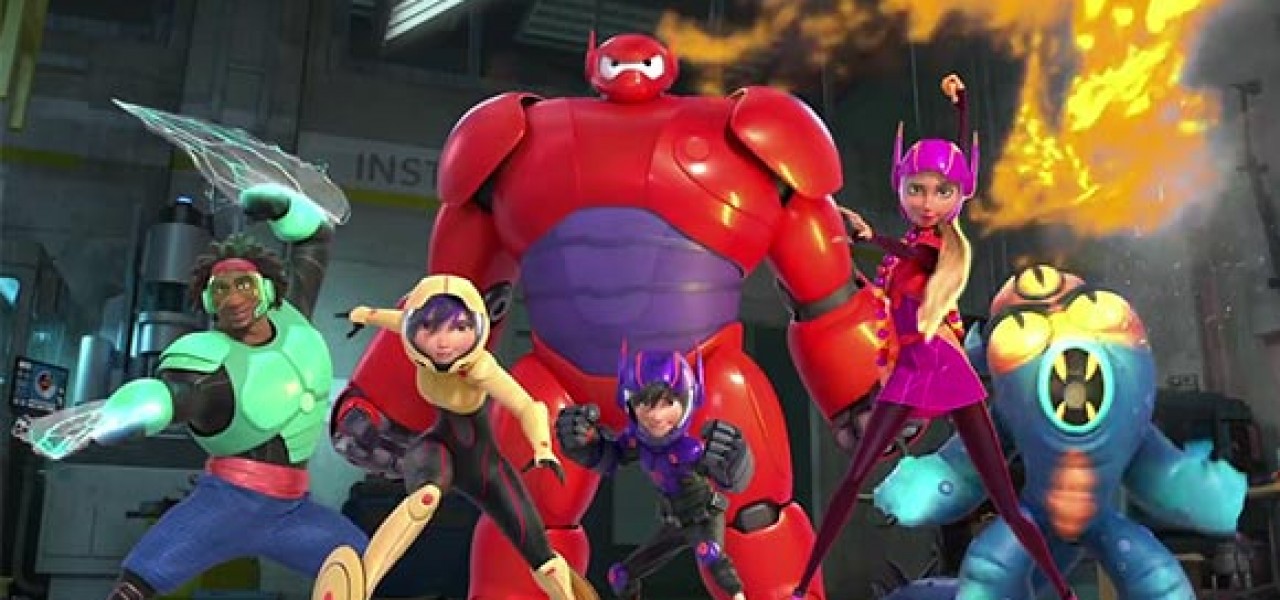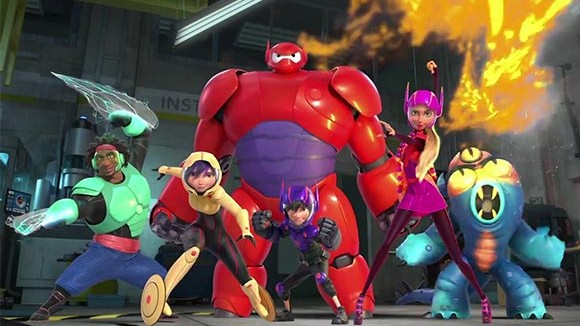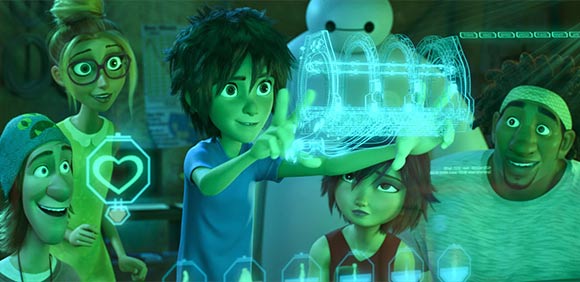

Oscar Ballot Guide: ‘Big Hero 6’ Acting and Performance Analysis

Part five of a five-part series in which Ed Hooks, author of Acting for Animators, does an acting and performance analysis of this year’s five Academy Award-nominated animated features.
Read his analyses of:
The Tale of The Princess Kaguya
How to Train Your Dragon 2
The Boxtrolls
Song of the Sea
In commercials, the product is the star, not the performers. I personally have appeared on camera in over one hundred commercials and have taught actors how to audition successfully for commercials, which are a primary source of income for SAG-AFTRA members. I have written books on the subject and know a commercial when I see one. Big Hero 6 is a commercial.
It is selling a new line of action figure toys for kids and is burnishing the Disney brand. There is nothing at all wrong with this, of course. I am just saying that, in the context of me preparing acting analyses of the five Oscar-nominated feature animation nominees, I am in a difficult place because Big Hero 6, directed by Don Hall and Chris Williams, functions aesthetically more like a feature-length commercial than it does like a movie, which makes it tricky to analyze the acting in it.
Performance in this movie has been calibrated to almost a scientific degree. There are a few surprises in it, notably the fact that it touches on human mortality, but it doesn’t go there in a thought-provoking way. I will get to that in a moment, but first we should talk just a bit about how and why big commercials—think Super Bowl—work like they do, and why they really cannot be scrutinized in the same way as a feature film (think Spirited Away, The Iron Giant).
National advertising depends on selling lifestyle to move product off the shelf. The implied message to TV viewers is, “If you buy this product, you will be like the people in the commercial—happy, friendly, hip, romantic, healthy, fertile and financially secure. If you buy this product, you will not have to trouble yourself with the ugly stuff that shows up on the evening news.” When I taught actors how to successfully book commercials, lesson #1 was that they should sell themselves, not the product. The ad agency is selling the product, and the actors are one of their tools.
Art—as opposed to commerce—is about communicating thoughts and perspectives on the human condition. We are storytelling animals, and we learn most of our survival strategies from stories. Brad Bird’s The Iron Giant communicated the idea that you can be what you want to be. “You don’t have to be a gun,” Hogarth said to the Giant. If humans have a non-negotiable mandate on Earth, it is to survive and get the next generation into being. If we fail at that, we are dinosaurs. Art talks about that kind of thing, encouraging thought and interaction between us. Commerce of the Super Bowl commercial variety distracts and diverts; it wants us to believe that if we simply drink Budweiser, we will have happy lives.

Now, to Big Hero 6: Look at the 6-plus minute sequence (54:16 – 1:00:41 Amazon Instant Video Streaming time code) during which the lead characters—Wasabi, Go-Go, Fred, Honey Lemon, Hiro Hamada and Baymax the inflatable nurse-robot—are first presented on screen in their colorful, super-power-enhanced hero costumes. There is no acting at all in those minutes, not if you apply Stanislavsky’s standards of objectives and actions. One adorable character after another is suited up and showcased with a few energetic introductory loop-the-loops while Fall Out Boy sings the theme song “Immortals,” that’s all. Happy people that are doing happy things with zero obstacles is not theatrically valid.
Hiro’s older brother, Tadashi, dies unexpectedly twenty minutes into the film, after being caught in a burning building. Significantly, we do not really know very much about him when he dies, other than he is smart, handsome, and looks after his orphaned brother. The Tadashi character has been used primarily for exposition and to introduce Aunt Cass, the boys’ stand-in mother figure, and the characters that will soon be known collectively as the Big Hero 6.

Once Tadashi is dead, the story shifts quickly into a pro forma ritual tribal grief ritual (23:21 – 24:30). It is wordless and slightly Asian in feel, as is the entire palette of the film—probably because China and Japan are important markets now. Black golf umbrellas pop open in Hallmark card unison against a sad and metaphoric gray-sky drizzle. At 23:49 we see the stereotypical village silhouette of everybody congregating around Tadashi’s grave. Then we move inside Cass’s apartment, to the wake. Everybody is subdued, dressed appropriately in sedate, respectful black. Note how Honey Lemon touches Wasabi’s back at 24:02, and how that touch makes you feel. The message is that, no matter what, we humans are one big family, and we must take care of each other. This is empathy at work, and Disney’s marketing team is masterful at using it. We share a communal group hug and then go on with living and buying things. Once again, note that there is no performance at all in this sequence, nothing for me to analyze. Nobody is playing actions in pursuit of provable objectives while overcoming obstacles. The sequence is an interlude, an emotional Hallmark-card snapshot of tribal ritual.
The next order of business is to get Hiro back into the action, as the main protagonist. First, we need to spend some non-acting sad-time with him. These kinds of moments are a potential trap for the big-budget animation filmmakers. Yes, the audience will empathize with a character’s sadness, but if they spend too much time with him moping around, they will switch from empathy to sympathy and start withdrawing emotionally.
Even the best animation directors still have the erroneous idea that emotion alone is enough in a story. I think it is a holdover from the Frank Thomas and Ollie Johnston days. Those early animation pioneers knew how powerful on-screen emotion could be, but they did not fully understand how acting works. The fact is that emotions are not actable. Acting is doing something. Stage and movie actors learn early in their training that trying to act emotions is an error called “indicating”, as in “indicating to the audience what the emotion is that they are seeing.” My immediate point is that emotion is not actable, and here (24:30) we have Hiro Hamada sadly meandering around in his darkened bedroom. A little bit of this goes a long way acting-wise. It is not, in fact, acting at all; it is the presentation of a mood. Co-directors Chris Williams and Don Hall choose to break with mood with a coincidence: Hiro drops his toy-controller on his bare foot, which activates and inflates Baymax. (26:06).

Baymax is an interesting character from a performance perspective because, unlike the human characters, he is programmed to always have an objective. He also has been endowed with the occasional illusion of emotion, an expression of personal values, and he always is playing actions. Baymax is a seriously clever character invention in that so many different things can be done with him. When we first meet him, his pre-programmed objective is to make Hiro feel better. Perfect! He will pursue his objective, and we now have the set-up for a scene. Hiro is almost back in the thick of things.
Note how Baymax squirms around in the tight bedroom space as he makes his way from behind the bed and into the center of the room. Significantly what he is doing requires thought that calibrates values. By the time he and Hiro are within touching distance, the audience already has accepted Baymax as a kinda-sorta human thing, a companion for Hiro. I suggest that you make a mental note of how and why the sequence works like it does because you may one day use it in your own animation.
Baymax is part of my personal favorite sequence (36:11 – 38:54) in Big Hero 6. There is some top-notch animation performance happening when he loses power and deflates because the creative decision was made to make him appear to be drunk. Acting drunk is fun for actors because a drunk person generally tries to act sober. The acting principle for all such sequences, regardless of the intoxicating substance, is to let it inhabit the body and then act to control it.
Hiro, like the good buddy he is, wants to help while simultaneously shielding Baymax from Aunt Cass’s view. His objective (provable) is to connect the robot to his recharger. His actions in pursuit of that objective change moment to moment based upon the stage of Baymax’s deflation. Both characters have conflict with their situation, so everything is theatrically valid. Keep in mind that comedy of all types is a factor of man’s limitations. (Drama is a factor of our potential.) We laugh when we watch this sequence because, even if we don’t drink alcohol, we have all been similarly debilitated at one time or another in our lives. Or we have had a friend that was in such a condition, and we had to help him. The creative team should be applauded for milking this bit for all it’s worth.

The villain in this story, Robert Callaghan, is a paper-doll, one-dimension baddie, a sociopath with whom we empathize not a whit. That works in a movie like this because the villain is simply a structural tool. The directors are not trying to teach us anything about life, where villains can easily look like priests. The idea here is to haul a villain up the flag pole and then knock him off so that we can all go shopping for action figure toys.
1:01:50 – 1:29:00 This half hour section is an extension of the commercial that began at 54:16, when we first were introduced to the action figures. Theatrically, it is a waste of time because there is never any doubt how it will turn out: Hiro and the other Heroes will use all their newly enhanced super-powers to defeat Robert Callaghan, rescue Callaghan’s daughter, Abigail, and Baymax will return from the dead just in time for the final group “selfie” (1:31:41)

We should spend a little time discussing the performance in this final thirty minutes because it is often theatrically valid and still does not evoke a lot of emotion in the audience. The Heroes have a group provable objective, namely to defeat Callaghan. All of their actions are in pursuit of that objective. Theoretically, they have conflict with their situation and with Callaghan, but this is conflict like in a TV commercial, not in real life. It is check-the-box conflict. I suggest that you try this experiment: Play this entire sequence while monitoring your own emotional responses on a yellow-line pad. What you will discover is that, on a scale of one-to-ten, with ten being emotionally overcome and one being totally untouched emotionally, you will consistently score in the three-range. The score jumps to five when Baymax is sacrificing himself to save Hiro’s life (1:26:42)—and, by extension, the entire world.
Big Hero 6 could be the centerpiece exhibit in a grad level marketing class. It works precisely the way it is supposed to, pursuing its own provable corporate objective of selling toys and building the brand. It looks and feels like a movie, but it is really a commercial. Kim Masters in her 2001 book The Keys to the Kingdom was on target when she quoted long-time Disney Company CEO, Michael Eisner, from a memo he sent to his staff, that read in part, “Success tends to make you forget what made you successful…We have no obligation to make art. We have no obligation to make a statement. To make money is our only objective.” Check.
ED HOOKS is the author of Acting for Animators, (revised third edition, Routledge, 2011). Ed pioneered Acting for Animators in 1998 while working with the animators at PDI/DreamWorks in northern California, and teaches the Acting for Animators masterclass internationally. For Cartoon Brew, he previously wrote a performance analysis of Disney’s Frozen. For more information about his practice, visit EdHooks.com
